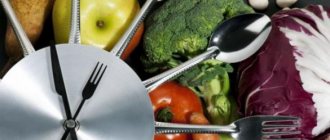The color and consistency of stool can tell a lot about both the state of the child’s body in general and the digestive system in particular. Moreover, most often parents are faced with the phenomenon of very light-colored feces in their child. Many parents are confused and don’t know what caused this color change and whether it is dangerous.
Even doctors cannot give a definite answer as to what a child’s stool should be like normally. This is influenced by a fairly large number of different factors: the age of the child, the nature of his diet. In principle, the average variant of the norm is considered to be mushy, light brown stool, somewhat reminiscent of apricot puree. And even then, it will take at least a week to form. Until then, a newborn baby’s stool can be anything.
READ ALSO - Treatment of gastritis in children
But if the baby’s stool is too light or, even more so, white, parents should be wary. Of course, you shouldn’t panic and assume the worst, but it’s still worth informing your pediatrician, since sometimes light-colored stool can be a symptom of various diseases. Feces acquire their standard brown color due to the presence of a special pigment in them - stercobilin. And if any malfunction occurs in the functioning of the internal organs, the production of this substance may not only be reduced, but also stop completely.
Baby food
If, apart from the change in the color of the child’s stool, nothing else bothers the baby, parents should also check the color of the child’s urine. If the color of the child’s urine has not changed and it has not become more saturated, stop panicking and just carefully watch the baby. Pay attention to your child's sleep, appetite, and behavior while awake. If something is bothering the baby, attentive parents will notice it very quickly.
READ ALSO - The clinic offers a range of services
When you first notice light-colored stool in your child, try to remember what your child ate the day before. Of course, if we are talking about a baby who feeds exclusively on mother’s milk, it is the mother who needs to reconsider her diet. If your baby is fed artificial milk formula, remember if you changed it the day before.
And even more so, it is necessary to pay special attention to what exactly the child ate if he is already old enough to eat the same thing that adult family members eat. For example, foods high in calcium can cause a child’s stool to become white, with a very thick and viscous consistency, like clay.
Think about whether your child ate cottage cheese with sour cream the day before, or maybe you overdid it with vitamins? In addition, this can happen due to the fact that the baby ate a lot of food rich in carbohydrates the day before. Therefore, carefully monitor what exactly and in what quantities your child eats.
What causes your baby's stool to turn yellow?
Almost black bowel movements with a greenish tint occur in a newborn baby. It is called meconium. In addition to color, it is distinguished by its viscous structure and stickiness. This original feces in a newborn disappears on the second or third day of life.
Yellow stool is normal in an exclusively breastfed baby. But if it has become bright, perhaps the milk is poorly absorbed, and you should show the baby to the pediatrician. Green feces in a breastfed baby are also considered normal. Especially if mom loves green vegetables, apples and pears, spinach and parsley. Artificially produced bowel movements are slightly darker, more like light brown.
Situations when stool turns light yellow or even white are also dangerous. The table below shows photos of yellow stool in a child, which is normal, as well as stool that signals danger, as in the case of white stool in a child.
Changes in the color and frequency of bowel movements in infants
Darkening of excrement occurs as the baby grows older. The beginning of this process coincides with the introduction of complementary foods, when a one-year-old child tries foods from the adult diet. But new dishes can also cause excrement to become lighter. A stable dark brown shade of stool in children is observed at approximately 2 years. If it turns yellowish or even reddish, this may indicate that the toddler is eating orange vegetables in large quantities, for example, pumpkin or carrots.
For very young children, you need to pay attention not only to the color of the stool, but also to the frequency of bowel movements.
So, a one-month-old baby has bowel movements after every meal. But when the child turns 2 months old, the frequency of stool decreases by four times. The little one can even go big once every two days. This occurs due to an enzyme crisis - the digestive organs adapt to the more complex composition of mother's milk.
Yellow feces in a child - as a symptom of illness
Yellow stool in a child sometimes signals pathologies of the liver, gallbladder and pancreas. Dysfunctions are caused by impaired bile secretion. They occur as a result of poor nutrition, inflammatory processes in the stomach and intestines, respiratory tract infections, scarlet fever and influenza, as well as helminthiasis. Another reason why the contents of a pot become bright yellow is intestinal infections.
The most common diseases in which the baby’s bowel movements turn yellow:
Stagnation of bile
The typical brownish tint to defecation products is given by a pigment released along with bile. If it does not leave the gallbladder, this element remains there, and the excrement becomes lighter. This condition is caused by obstruction of the bile ducts or the congenital structure of the gallbladder, for example, its bending or twisting.
Pancreatitis
This disease is quite rare in young children, but sometimes it still happens in some toddlers. In addition to pale yellow stool in the baby, it is manifested by such signs as nausea, painful sensations in the upper part of the peritoneum, radiating to the lower back. Caused by inflammatory processes in the pancreas.
Rotavirus infection
Rotavirus most often affects children from 5 months to three years. The disease is characterized by nausea, yellowish diarrhea, and lack of appetite. The temperature rises, the nose is stuffy, the throat hurts. Yellow mucus in a child's stool can also signal rotavirus or another intestinal infection. Caused by a virus of the genus Rotavirus, usually through dirty hands from another sick child.
If you have severe diarrhea, fever and bloody discharge in your bowel movements, you should call emergency help. Internal bleeding and dehydration can lead to serious consequences, even death. If only the color of the baby’s stool changes, but the consistency and smell do not, there are no inclusions of blood, nutrition is probably the deciding factor. If the child remains in good health, serious medical care is not required. You should see a doctor if indigestion and abnormal stools last more than five days. Consultation will be required when a change in the color of stool is accompanied by nausea, vomiting, or diarrhea.
We also recommend reading: Green feces in a child: normal or serious danger
Remember that only a doctor can make a correct diagnosis; do not self-medicate without consultation and diagnosis by a qualified doctor. Be healthy!
Other reasons
Pediatricians say that very often a child’s light-colored stool appears during the period when his teeth begin to emerge. The nature of this phenomenon has not been fully studied, but the fact remains. Therefore, if the child does not exhibit any other symptoms, just carefully monitor the baby’s condition. And it is also necessary to notify the doctor.
Also remember if you gave your child any pharmacological drugs the day before. Many medications can cause a child's stool to become lighter in color.
In general, many young mothers report that their baby’s stool periodically becomes lighter in color. And my health does not suffer at all. Several days pass and the color of the stool returns to normal without any special measures.
Reasons for color change
Poor nutrition is a common cause of yellow, loose stools in children. This includes fatty dairy products (cottage cheese, sour cream, milk). Also, changes and lightening of stool can accompany teething.
In addition, there are many reasons for a child to have green-yellow loose stools.
The mother should be alert to general signs of the baby’s condition: temperature, appetite, sleep. If changes in these indicators are observed, then lightening stool signals an emerging disease. It is necessary to urgently contact a pediatrician.
Flu
When you have the flu, the color of your baby's stool becomes very light with a gray tint. Lightening begins already on the 3rd day of illness, but it can also appear as a consequence of the flu after recovery.
Then it is worth talking about the body’s attempt to cleanse itself of excess medications, if the child was treated with such drugs.
Rotavirus infection
This disease causes fever, sore throat, diarrhea and vomiting. Symptoms, like those of poisoning, last up to a week.
The stool first turns yellow and becomes liquid, and then takes on the appearance of yellow-gray clay.
The treatment for this disease, as pediatrician Komarovsky advises, is taking sorbents (Smecta) and increasing the water-salt balance, that is, drinking plenty of water.
Reaction to drugs
The presence of yellow stool in a child, due to high susceptibility, is directly related to the use of certain medications. The baby’s liver reacts very quickly to the administered antipyretic, analgesic or antibacterial agent.
Antipyretic:
- Paracetamol;
- Aspirin and its derivatives.
Painkillers:
- Ibuprofen;
- Diclofenac;
- Nimesulide.
Antifungal:
- Griseofulvin.
Antiepileptics:
- Acediprol;
- Convulex;
- Leptilan;
- Valproic acid.
If a reaction to a particular drug occurs, expressed in yellowing of the child’s stool, consultation with a pediatrician and the attending physician is required to avoid complications in the liver and gastrointestinal tract.
Teething
The most common reason for changes in the consistency and color of infants' stool is teething. It would seem that such an unrelated phenomenon as the appearance of baby teeth in a baby directly affects his intestines. Mucus appears in the stool, like snot, it becomes yellow-green, watery with foam. It is worth being very attentive to the baby during this period, as immunity decreases, and against this background it is easy to catch a viral infection.
However, when teething occurs, not only the color of stool changes. They become more liquid, sleep becomes restless, a slight fever appears, the baby refuses to eat, and the gums become swollen and red.
Dysbacteriosis
Yellow and greenish stool in infants may be a sign of dysbiosis. A rash appears on the baby's body. Such signs occur especially often with mixed formula and breastfeeding.
Factors leading to a bacterial imbalance in the baby’s intestines include illnesses suffered by the mother during pregnancy, antibiotics taken by the baby, as well as the quality of the baby’s feeding.
With dysbacteriosis in one-year-old children, light, mucous green stools are observed, foamy with air and a sharp sour odor. There are undigested lumps of food and streaks of blood.
Hepatitis
One of the most dangerous causes of light yellow stool in children is hepatitis, or jaundice. However, yellowing of stool is not the only sign of this disease. Other factors of hepatitis include the general unsatisfactory condition of the child (weakness, nausea, lack of appetite), dark urine, feces gradually changes in color from brown to almost white and gray.
In the presence of hepatitis B, there may be a latent period of development of the disease of up to six months, so this form of the disease is rare in infants. The active phase of the disease always begins with darkening of the urine, followed by lighter stool. The baby becomes lethargic, sleep and appetite worsen, vomiting and fever appear.
With hepatitis A, the baby's stool gradually becomes yellow and the urine darkens. Further, the stool becomes completely white, and the accompanying symptoms are similar to those that appear with hepatitis B, which is viral in nature. These are accompanied by pain in the right hypochondrium, yellowness of the sclera of the eyes and skin, and bloating.
If these signs of illness appear, immediately consult a pediatrician or an infectious disease specialist, since hepatitis that is not detected and treated in time becomes chronic, which can lead to cirrhosis of the liver. In addition, a child with signs of hepatitis is dangerous for people around him - the risk of transmitting the virus increases in the active phase of the disease.
What if something is wrong?
However, unfortunately, everything is not always so rosy. It often happens that a child’s stool becomes light-colored due to various disruptions in the normal functioning of the body. Most often, malfunctions occur in the gastrointestinal tract: liver, gallbladder, pancreas, intestines.
Therefore, in some cases, light-colored feces may indicate the presence of diseases in a child such as:
- Dysbacteriosis
If the baby suffers from dysbacteriosis, his stool becomes liquid, with green streaks of mucus and, as a rule, a much lighter color than usual. In particularly severe cases of the disease, the stool may foam and emit a rather unpleasant odor. In addition, the child may suffer from severe abdominal pain, increased gas formation, and sometimes even skin rashes. In any case, parents should seek medical help as soon as possible.
- Hepatitis
As a rule, it is hepatitis that parents fear most when they notice lightening of their baby’s stool. But you shouldn’t panic right away - such a serious diagnosis should only be made by a doctor. And even then not immediately, but after a thorough examination of the child and a series of laboratory tests.
The only thing parents can immediately do on their own is to check the condition of the child’s urine. If a child has hepatitis, his urine will always be very dark - there are no exceptions to this rule. And stool with hepatitis is most often not just light, but with a certain grayish tint. And you should not try to look for signs of yellowing of the child’s skin - this may happen several days later.
- Inflammation of the pancreas
It is widely believed that inflammation of the pancreas is a purely adult disease. In fact, this is not at all the case, because, unfortunately, it occurs no less often in very young children. This disorder occurs under the influence of a variety of factors. However, one of the leading symptoms of the disease is always light-colored stools.
In addition, the child may suffer from pain in the navel area and the upper right side of the abdomen. In addition, when the pancreas is inflamed, a child may also experience nausea and vomiting, a strong feeling of thirst, and sometimes even an increase in body temperature. By the way, very often the trigger for inflammation of the pancreas is excessive consumption of chocolate by children. Yes, by the way, and any other sweets too.
- Bend of the gallbladder
In some cases, the cause of lightening of the stool in a child may be a bend in the gallbladder. Due to the bending of the gallbladder, bile and the coloring pigment, which give the stool its usual color, are excreted extremely poorly. If the doctor suspects this in your baby, he will certainly prescribe an ultrasound examination.
- Rotavirus infection
In the event that a child’s stool becomes lighter as a result of rotavirus infection, the picture of the disease is quite typical. First, the child’s body temperature rises, then symptoms of intoxication appear: vomiting, diarrhea. Changes in stool color in such cases are also quite typical. On the first day, the stool is liquid and yellow in color, but already on the second day the color becomes whitish, similar to clay.
However, in addition to all this, the child has all the symptoms that are typical of a common acute respiratory disease: headache, runny nose, cough, sore throat. The baby is lethargic, refuses to eat, is capricious, and sleepy. If the child’s treatment is started in a timely manner, such a condition does not pose a particular threat to his body. But it is still necessary to consult a doctor, since the child’s body is capable of presenting surprises. And often very unpleasant.
- Whipple's disease
This disease is extremely rare, and the causes of its development have not yet been fully identified. A sick child's body temperature rises significantly, iron deficiency anemia develops, and inflammation of the lymph nodes develops. In addition, a sick child has very frequent bowel movements - about 10 times a day. The stool of a sick child is light gray and has a very pungent odor.
Factors influencing the appearance of yellow stool
Stercobilin, a derivative of bilirubin, gives stool a typical red-brown hue. If there is not enough stercobilin in the body, the stool becomes yellow. The main reason for low stercobilin levels is a deficiency of bilirubin due to stool passing too quickly through the intestines or due to too much feces. Bilirubin is produced in the liver as a result of the conversion of hemoglobin, which moves oxygen from the blood to the internal organs. If pathological processes occur in the liver, much less bilirubin is produced than normal.
Factors influencing changes in stool color:
- Liver diseases.
Liver diseases such as cirrhosis and hepatitis (as well as gallbladder disorders) can reduce the amount of bile salts produced in the body. The combination of yellow stool with a change in its consistency is a sign of a deficiency of bile salts in the body, infection, or impaired liver function.
Viral, autoimmune or toxic hepatitis can also cause yellow stool. Most often these changes are caused by a viral infection. Yellowing of the stool causes mononucleosis, a disease whose symptoms are detected after a blood test.
- Diseases of the pancreas.
Conditions such as pancreatitis, cystic fibrosis, pancreatic cancer, and a blocked pancreatic duct can cause yellow or pale stools.
A pale yellow tint to feces may appear after eating large amounts of fatty foods for a long time. In this case, the feces acquire an extremely unpleasant odor. This reaction of the body to fatty foods may indicate a dysfunction of the pancreas.
- Cytomegalovirus.
Cytomegalovirus infection can leave its mark on the functioning of the liver, as can infection with rubella, mumps, and alcohol abuse.
- Intestinal disorders.
A change in the consistency of feces often accompanies intestinal disorders caused by the introduction of infection into the human body.
Stress has also been shown to influence the occurrence of irritable bowel syndrome. Stress control is a fairly important factor [1] (on the topic: 10 ways to relieve stress).
- Celiac disease.
If a person with celiac disease eats gluten (the protein in wheat, rye and barley), their immune system attacks this undigested protein, including the tissue in the small intestine, damaging it and impairing the ability to absorb nutrients.
According to the National Celiac Disease Foundation, more than 300 different symptoms are associated with celiac disease. This makes diagnosis difficult. [2]
- Giardiasis
is a common intestinal infection caused by a microscopic parasite. One of the symptoms of giardiasis is foul-smelling yellow diarrhea.
- Yellow products.
Carrots (especially fresh carrot juice), sweet potatoes, turmeric and other yellow foods can turn your stool yellow. If you regularly have yellow stools due to your diet, then you should avoid fatty and processed foods, as well as gluten. In addition, yellowing of the stool may be a side effect of taking medications with a high content of β-carotene.
A change in the color of stool from green to yellow can be observed when the intestines are infected, because the rate of transport of digested foods through the intestines in this case is extremely high. In this case, the feces do not have time to acquire their usual color. Another reason why stool turns yellow is a deficiency of bile in the body.
Diagnostic methods
At the first suspicion of deterioration of the digestive system in a child, you should seek help from a pediatrician. The doctor will definitely interview the patient (parents), conduct a visual examination, and palpate the abdomen. To exclude possible gastrointestinal diseases, laboratory tests and hardware examination are recommended. If the stool is light yellow, then you should make sure that there are no inclusions of mucus, blood, epithelium, or starch.
Fluoroscopy and ultrasound will not be superfluous. These methods allow you to generally assess the condition of the internal organs. If the examination does not give a clear answer, then additionally endoscopy, manometry and electroenterogastrography are performed
Biliary tract pathologies
Yellow stool in a child may be a sign of pathology of the biliary tract and pancreas. The most common diseases are cholecystitis, pancreatitis, gallbladder inflection and bile stagnation.
Cholecystitis
With cholecystitis, in addition to yellowing of the stool, there is pain in the epigastrium, appetite worsens, nausea and even vomiting appear.
The causes of the disease are quite extensive. This is both a genetic predisposition and a consequence of poor nutrition. In addition, cholecystitis occurs against the background of previous viral diseases (influenza, tonsillitis, scarlet fever), with concomitant gastritis, and the presence of Giardia.
Pancreatitis
Here the pancreas becomes inflamed, the stool becomes lighter and yellow, pain and bloating appear in the abdomen. The child suffers from paroxysmal stomach pain, nausea and vomiting, and experiences periodic constipation. This disease can affect both adult and very young children. The reason for its appearance is poor nutrition and an unformed pancreas.
Eating large amounts of sweets also leads to the development of pancreatitis. With such a diagnosis, the gastroenterologist should give treatment in the form of enzyme preparations that help the pancreas, and a diet (table No. 5), in which the child is asked to eat a dietary menu.
In rare cases, attacks of pain in the abdominal area are so severe that it is very difficult to independently help a child with colic. Therefore, you should contact the hospital’s pediatric emergency department as soon as possible to provide appropriate qualified assistance.
By adjusting your baby’s diet, you will relieve him of attacks of pain in the abdominal area.
Biliary disorders
Inflection of the gallbladder and stagnation of bile are mutually related pathologies of the biliary tract. In this case, yellowing of the stool, constant pain in the right hypochondrium, nausea after eating, vomiting are also observed, which causes cracks in the corners of the mouth and a coating on the tongue.
The bend occurs as a result of cholecystitis, and in connection with this, stagnation of bile begins. This occurs from poor nutrition and gallbladder dysfunction. With stagnant bile and its lack in the intestines, the stool turns yellow.
Advanced cholecystitis and along with it stagnation of bile can manifest itself in the form of diabetes mellitus, decreased vision and deterioration of vascular and muscle tone.








